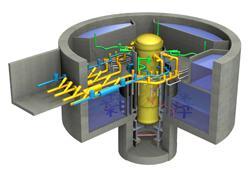
2 minute read
3.3.5 Transport of radioactive materials
automatically and, in many cases, can be initiated by the operators of the nuclear reactors. Some engineered systems still operate passively (for example, using pressure relief valves) and function without operator control or loss of auxiliary power. Most of the Gen II plants still in operation in the West were manufactured by one of three companies: Westinghouse, Framatome4 (now part of AREVA5), and General Electric (GE).
The Korean Standard Nuclear Power Plant (KSNP), which is based on Gen II technology developed by Combustion Engineering (now Westinghouse) and Framatome (now AREVA), is now recognized as a Gen II design and has evolved to become the KSNP+. In 2005 the KSNP/KSNP+ was rebranded as the OPR-1000 (Optimized Power Reactor) for Asian markets, particularly Indonesia and Vietnam. Six OPR-1000 units are in operation, and four are under construction. China’s existing and planned civilian power
fleet is based on the PWR. Two important designs used in China are the improved Chinese PWR 1000 (the CPR-1000), which is based on Framatome’s 900 megawatt (MW) threeloop Gen II design, and the standard PWR 600 MW and 1,000 MW designs (the CNP series).
Fig: 3.6 WWER-1000 (or VVER-1000 as a direct transliteration of Russian ВВЭР1000) a 1000 MWe Russian nuclear power reactor of PWR type.
3.2.3 Generation III
Gen III nuclear reactors are essentially Gen II reactors with evolutionary, state-ofthe-art design improvements. These improvements are in the areas of fuel technology, thermal efficiency, modularized construction, safety sys- tems (especially the use of passive rather than active systems), and standard- ized design. Improvements in Gen III reactor technology have aimed at a longer operational life, typically 60 years of operation, potentially to greatly exceed 60 years, prior to complete overhaul and reactor pressure vessel re- placement.
Fig 3.7: Cut-away view of a Gen III GE-Hitachi Nuclear Energy reactor design
Confirmatory research to investigate nuclear plant aging beyond 60 years is needed to allow these reactors to operate over such extended life- times. Unlike Gen I and Gen II reactors, Gen III reactors are regulated by NRC regulations based on 10 CFR Part 52.
The Westinghouse 600 MW advanced PWR (AP-600) was one of the first Gen III reactor designs. On a parallel track, GE Nuclear Energy designed the Advanced Boiling Water Reactor (ABWR) and obtained a design certification from the NRC. The first of these units went online in Japan in 1996. Other Gen III reactor designs include the







